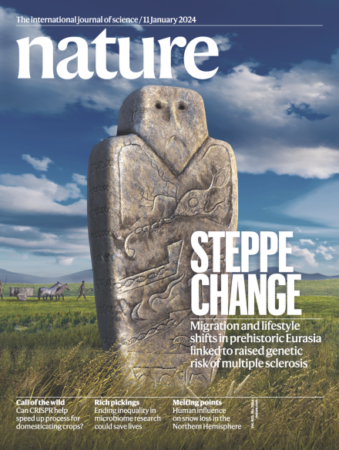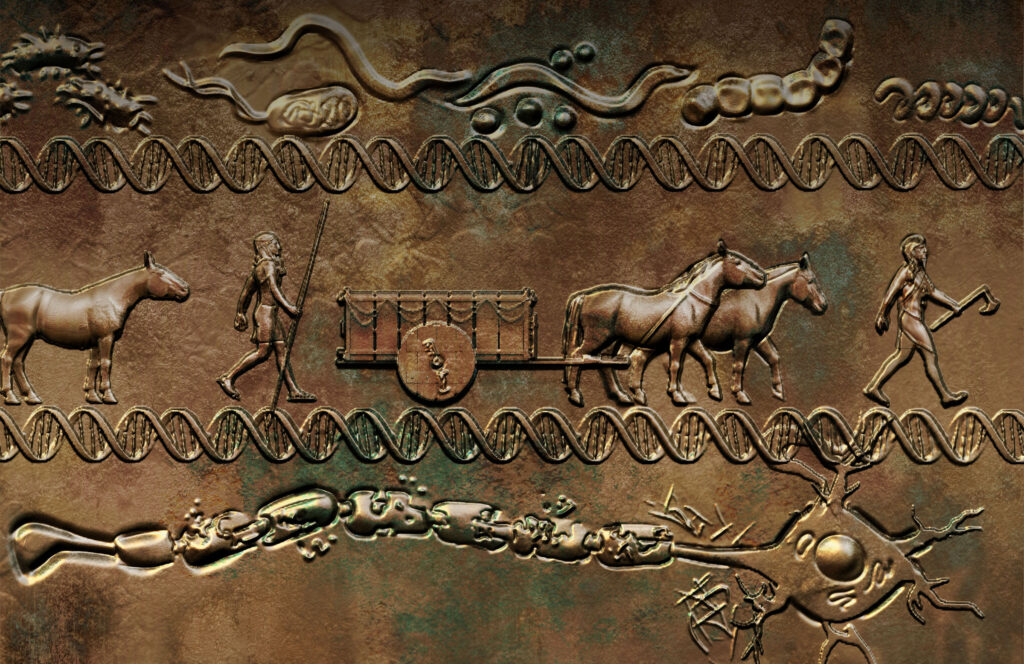Nature Journal Cover Art: Haunted by Genes from Our Past
How Once Advantageous Adaptations may Cause Disease Today

Why do genes detrimental to our health—like those that predispose us to autoimmune diseases—exist? Featured Nature journal cover art from SayoStudio represents recent findings from a consortium of researchers investigating this question. They studied the potential origins of ancient DNA that predispose us to multiple sclerosis (MS) and other diseases. We worked with first author William Barrie, Cambridge University, to illustrate their group’s research that marries genetics and anthropology.
Barrie and 29 authors across 16 institutions contributed their studies of the Yamnaya people. With the magnitude and significance of the research, they invested in a package of four science illustrations from SayoStudio. The selected Nature cover art is a 3d digital painting depicting the Yamnaya people. The Yamnaya, also known as the pit-grave people, were early—perhaps the earliest—pastoralist people. How, you might ask, do the Yamnaya connect to MS?
Weaving Archeology, Genetics, and Disease in Conceptual Science Art

To illustrate MS’s connection to people’s long past, SayoStudio met with Barrie to learn more about their science. Alongside our internal research, the storyline evolved as he detailed the connections. MS, characterized by symptoms arising from the immune system targeting the protective cells around neurons, traces its origins back 5,000 years. MS is complex, and not a strictly hereditary disease. Surprisingly, having a family member with MS only slightly elevates the risk by 1.5%.
However, medical experts have observed a predisposition to MS among individuals of Northern European descent. Their study analyzed the largest database of archeological DNA, all the way back to the Stone Age. They discovered that MS-implicated genes can be pinpointed to a very specific time and region, going back to the nomadic Yamnaya people of the Bronze Age.
The Yamnaya’s Lifestyle and Adaptations
The Yamnaya people, largely regarded as the first pastoralists, traveled with horses, cows, and other livestock across the Central Asian Steppes into Europe. Today, Northern Europeans can trace 40-50% of their DNA back to the Yamnaya. Compared to previous generations, the Yamnaya’s diet relied heavily on dairy and meat. The researchers hypothesize that this lifestyle and diet introduced them to new pathogens residing in/on their animals.
In turn, they retained DNA adaptations that protected them from these pathogens. Unfortunately, these protective adaptations remained in our genome long past their usefulness. Now, these pathogens are long gone due to the passage of time and our modern lifestyles devoid of livestock. Yet, the DNA changes still exist, and the genetic changes prime the immune system to damage our neurons. Through our visual representations, we helped distill these complex findings into compelling visuals that offered four options of cover art to help communicate the science of this groundbreaking study.

Communicating Science Concepts for Collaborative Research Groups

In the same Nature issue, Barrie’s colleagues used a similar approach to study the anthropological genetic bases of other diseases. Knowing that the Nature issue featured 3 related studies, Cambridge asked us to create a conceptual illustration encompassing all of these studies. SayoStudio wove together the stories of all 3 research groups, illustrating the disease origins for the fourth of our science cover series.
With access to a database spanning the Stone Age to medieval times, the two other teams of archeologists, geneticists, and computer scientists found similar findings for diabetes and rheumatoid arthritis. They show that diabetes has roots in the first farmers, while arthritis originated during the time of hunter-gatherers. Our team conceptualized this final illustration as a comprehensive visual summary to encapsulate all of these findings.
Wrapping up the Nature Cover Art Suite for Press Releases
We’re humbled to have had the opportunity to communicate this monumental science that intersects archeology, genetics, and disease. Congratulations to Barrie and all of his colleagues for their work and recognition in Nature. We’re thrilled to see SayoStudio’s cover represent their research, and so happy to see all of the illustrations used in their press packages and communication.
This research is fascinating in its own right, but it’s also exciting to imagine what implications it has for how diseases are studied. We look forward to how this research approach might be applied to other modern diseases, as archeological DNA databases from around the world are broadened.
Here at SayoStudio, we are so fortunate to get to work with incredible scientists. You can see some of the other fascinating research that we’ve created covers for in our article on science cover art, and check out another of our favorites the Human Cell Atlas Science Cover. If you’re still curious for more, we recently published a survey of SayoStudio’s Science Communication in 2023. Thanks for reading!

I never would have come upon your site, but the illustration of the bronze panel that is on every news feed was so arresting that I had to look you up. You captured our cellular history so succinctly , it makes the study tangible. Well done.